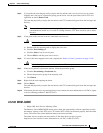
2-84
Cisco ONS 15327 Troubleshooting Guide, R3.4
March 2004
Chapter 2 Alarm Troubleshooting
Alarm Procedures
Step 2 If the cabling is correct, verify that the correct port is in service (IS):
Step 3 Confirm that the OC-N card shows a green LED in CTC or on the physical card.
A green LED indicates an active card. An amber LED indicates a standby card.
f. To determine whether the OC-N port is in service, double-click the card in CTC to display the card
view.
g. Click the Provisioning > Line tabs.
h. Verify that the State column lists the port as IS.
i. If the State column lists the port as OOS, click the column and choose IS. Click Apply.
Step 4 If the correct port is in service, use an optical test set to confirm that a valid signal exists on the line.
For specific procedures to use the test set equipment, consult the manufacturer. Test the line as close to
the receiving card as possible.
Step 5 If the signal is valid, ensure that the transmit and receive outputs from the DSx panel to your equipment
are properly connected.
Step 6 If a valid signal exists, replace the DS-N connector on the MIC card.
Step 7 Repeat Steps 1 through 5 for any other port on the card that reports the LOS.
Step 8 If the alarm does not clear, look for and troubleshoot any other alarm that might identify the source of
the problem.
Step 9 If no other alarms exist that might be the source of the LOS, or if clearing an alarm did not clear the
LOS, complete the “Physically Replace a Card” procedure on page 2-130 for the reporting card.
Note When replacing a card with an identical type of card, no additional CTC provisioning is
required.
Step 10 If the alarm does not clear, log onto http://www.cisco.com/tac for more information or call TAC to report
a service-affecting problem (1-800-553-2447).
2.6.113 LOS (OC-N)
• Critical (CR), Service Affecting (SA)
An OC-N LOS alarm occurs when a SONET receiver detects an all-zero pattern for 10 microseconds or
longer. An LOS alarm means the upstream transmitter has failed. If an OC-N LOS alarm is not
accompanied by additional alarms, a fiber break is usually the cause of the alarm. The condition clears
when two consecutive valid frames are received.
Warning
Invisible laser radiation might be emitted from the end of the unterminated fiber cable or connector.
Do not stare into the beam directly with optical instruments. Viewing the laser output with certain
optical instruments (for example, eye loupes, magnifiers, and microscopes) within a distance of 100
mm might pose an eye hazard. Use of controls or adjustments or performance of procedures other than
those specified might result in hazardous radiation exposure.


















